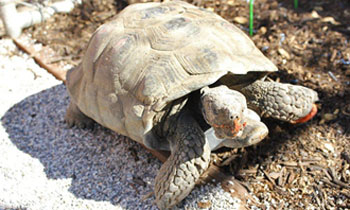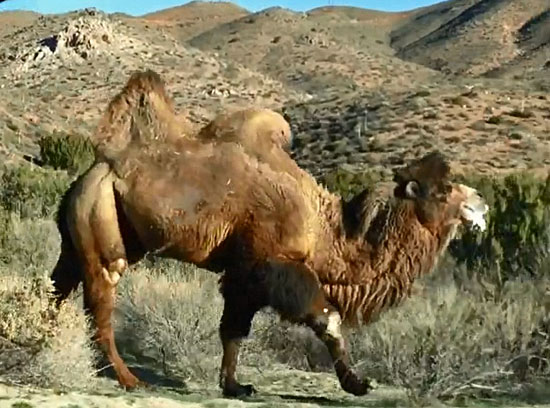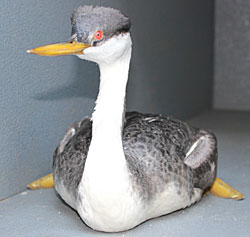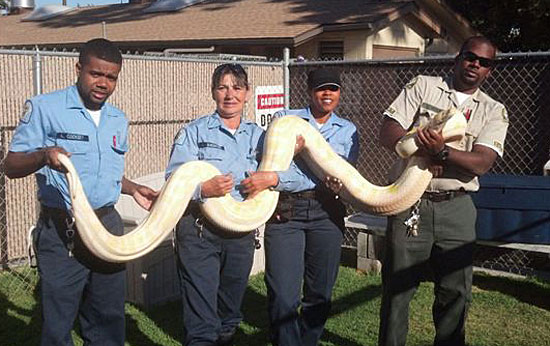L.A. County’s animal magnetism
October 1, 2014
It’s a jungle out there.
Also a savanna, a desert and occasionally a rainforest.
The recent capture of a rare white cobra by L.A. County Animal Care and Control officers made headlines around the world as people marveled at the mysterious appearance of a dangerous creature more commonly associated with the Indian subcontinent than with Southern California suburbia.
But the cobra caper—a first for the department—was only the latest chapter in a long-running saga of exotic animal encounters in and around the nation’s most populous county.
“About a year ago, we had a very aggressive camel that attacked a man,” recalled Marcia Mayeda, the department’s director. “It was a Bactrian camel, the kind with the two humps.” The camel, named Wally, “belonged to a person who uses him for media shoots, movies and so forth. He had escaped from his pen outside of Palmdale, and was wandering the streets.”
And Wally has plenty of company.
“We get everything,” Mayeda said. “Every kind of reptile—caimans, crocodiles, alligators. People get these animals as pets and they get too big and too dangerous and then they can’t handle them anymore. They usually abandon them because they don’t know what else to do with them. The same with very large snakes.”
Beyond ill-advised household pets gone wild, Southern California disasters also smoke out some unlikely creatures.
“When the fires happen and we have to evacuate large numbers of animals, we go expecting to get horses, ponies or goats, or sometimes cattle. But there was a time there was a whole troupe of monkeys that needed to be removed from somebody’s property,” Mayeda said. “During the Station Fire, there was a man who had an African elephant and a rhinoceros and was asking us for assistance.” (He ended up finding another ride out of harm’s way for his animals.)
Over the past five years, the department has logged 202 tortoises, 125 lizards, 97 parrots, 24 gophers and 23 chinchillas.
Thirteen tarantulas and an equal number of frogs have passed through the system, along with 60 fish, 17 bobcats, 5 scorpions, three badgers and a weasel.
Animal control officers also have run into enough out-of-the-ordinary critters to populate a good-sized ark—including two alligators, two of the alligator-like caimans, two wolves and two muskrats—as well as a few animals with vocabulary-challenging names (like the serval, a spotted wild cat.)
It all happens against a backdrop of the more routine encounters that keep Los Angeles County shelters busy day in and day out.
While cobras, tarantulas, wolves and their ilk are classified as “other,” their numbers are dwarfed by the sheer number of daily encounters with dogs and cats. In fiscal 2013-14, for example, 6,362 animals categorized as “other” passed through county shelters, compared to 37,535 dogs and 28,027 cats. (Cougars and bears, which also show up with some frequency, are the province of the state Department of Fish and Wildlife.)
Rare beasts have been found in virtually every corner of the county. The Antelope Valley is a particularly rich source.

Reptiles, including this Sulcata tortoise, are no strangers to Los Angeles County animal control officers.
“You never know what people have up there,” Mayeda said. “They’re out in the middle of nowhere, they get all sorts of exotic animals and they’re zoned for it, too. A lot of the companies that provide animals for film and TV are located up there.”
Then there’s Thousand Oaks, a Ventura County community which contracts with the L.A. County Department of Animal Care and Control for services. Not only was the ordinarily quiet area the site of the Great Cobra Hunt; recently a capybara, known as the world’s largest rodent and weighing in at up to 100 pounds, turned up there as well.
There’s no designated exotic animal handler on the county staff. “Whoever catches the call, they’re going to have to figure it out or call for help,” Mayeda said. “Nobody’s ever handled a cobra before. We’ve handled plenty of rattlesnakes, but cobras are different—faster and a lot more dangerous.”
The white cobra is now safely under quarantine at the San Diego Zoo. And, in case you’re wondering, Wally the rogue camel has been relocated to a more secure facility—in Ventura County.
Posted 10/1/14















 405 bridge work causes a stink
405 bridge work causes a stink
